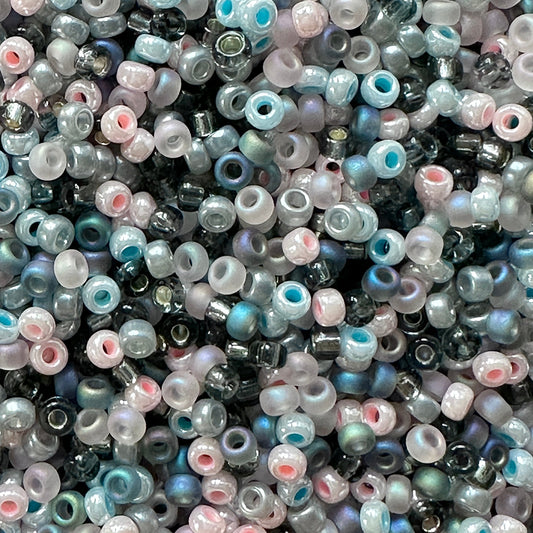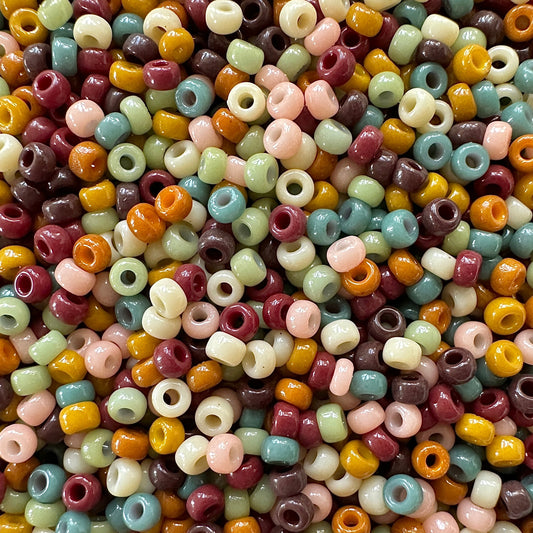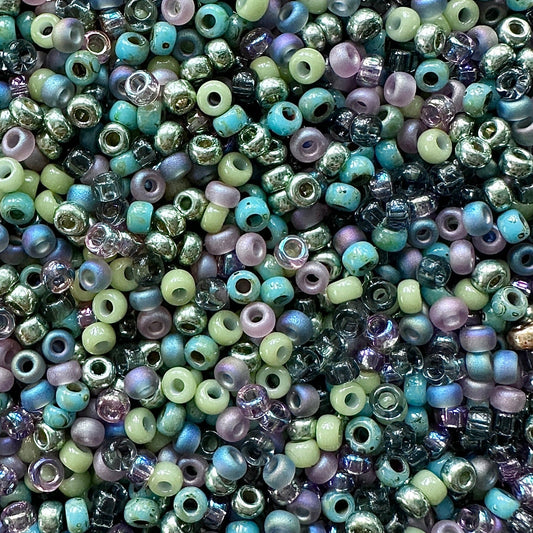SEED BEADS 101
What are seed beads?
Seed beads are small beads, like tiny plant seeds, made of glass or other materials. They are typically donut or round in shape and come in a vast array of colors, sizes, and finishes. From delicate necklaces and bracelets to intricate bead weaving and embroidery, seed beads offer endless possibilities for creative expression.
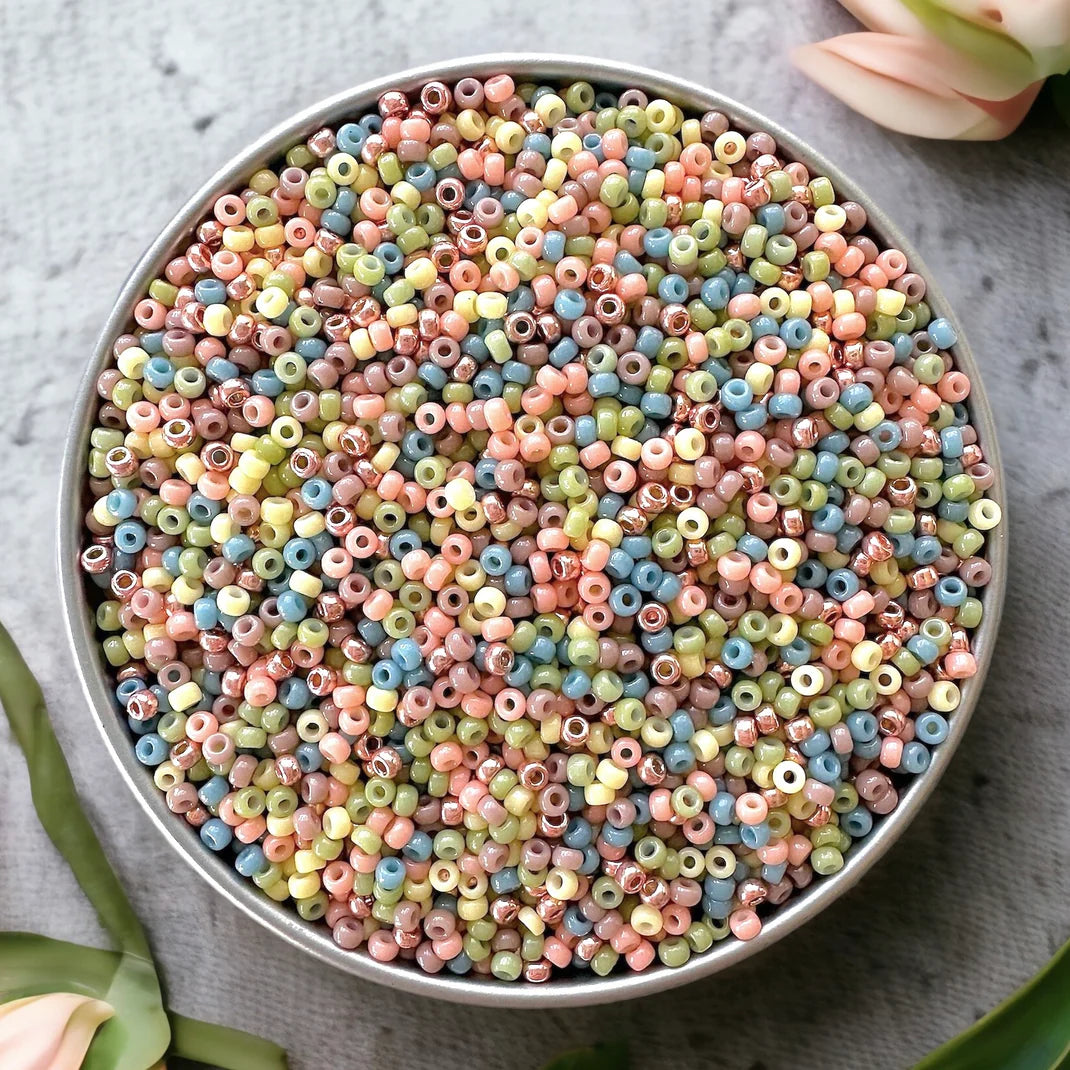
What are seed beads used for?
Jewelry Making
Seed beads are commonly used in creating jewelry pieces such as bracelets, necklaces, earrings, and rings. They can be strung on beading wire or cord. They can also be woven together to create beautiful and intricate designs, which I'll discuss more below.
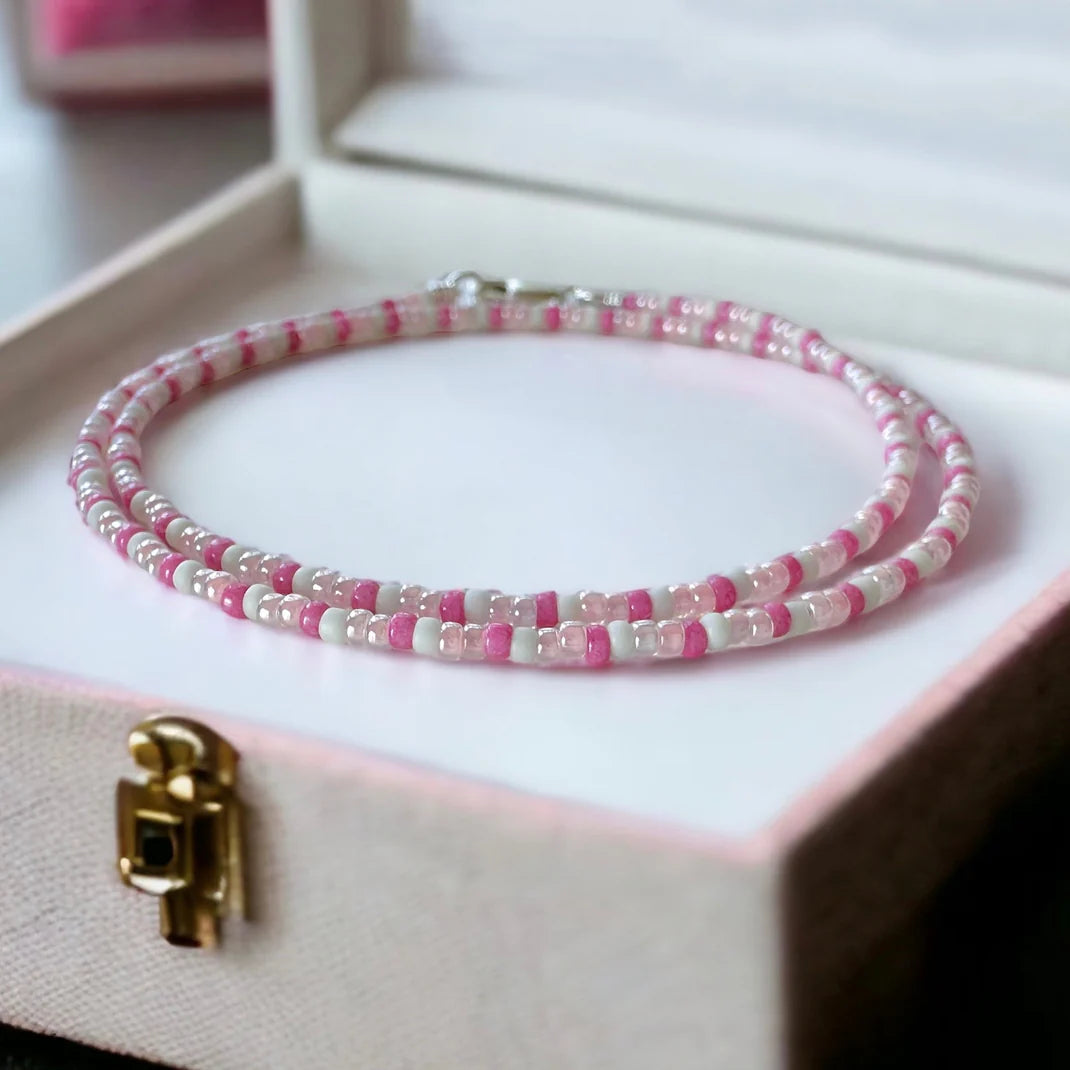
Bead Weaving
Seed beads are the main type of bead used in bead weaving techniques, such as peyote stitch, brick stitch, herringbone stitch, and square stitch as well as loom weaving. These techniques involve stitching beads together to create fabric-like structures that can be turned into jewelry, accessories, or even larger decorative pieces.
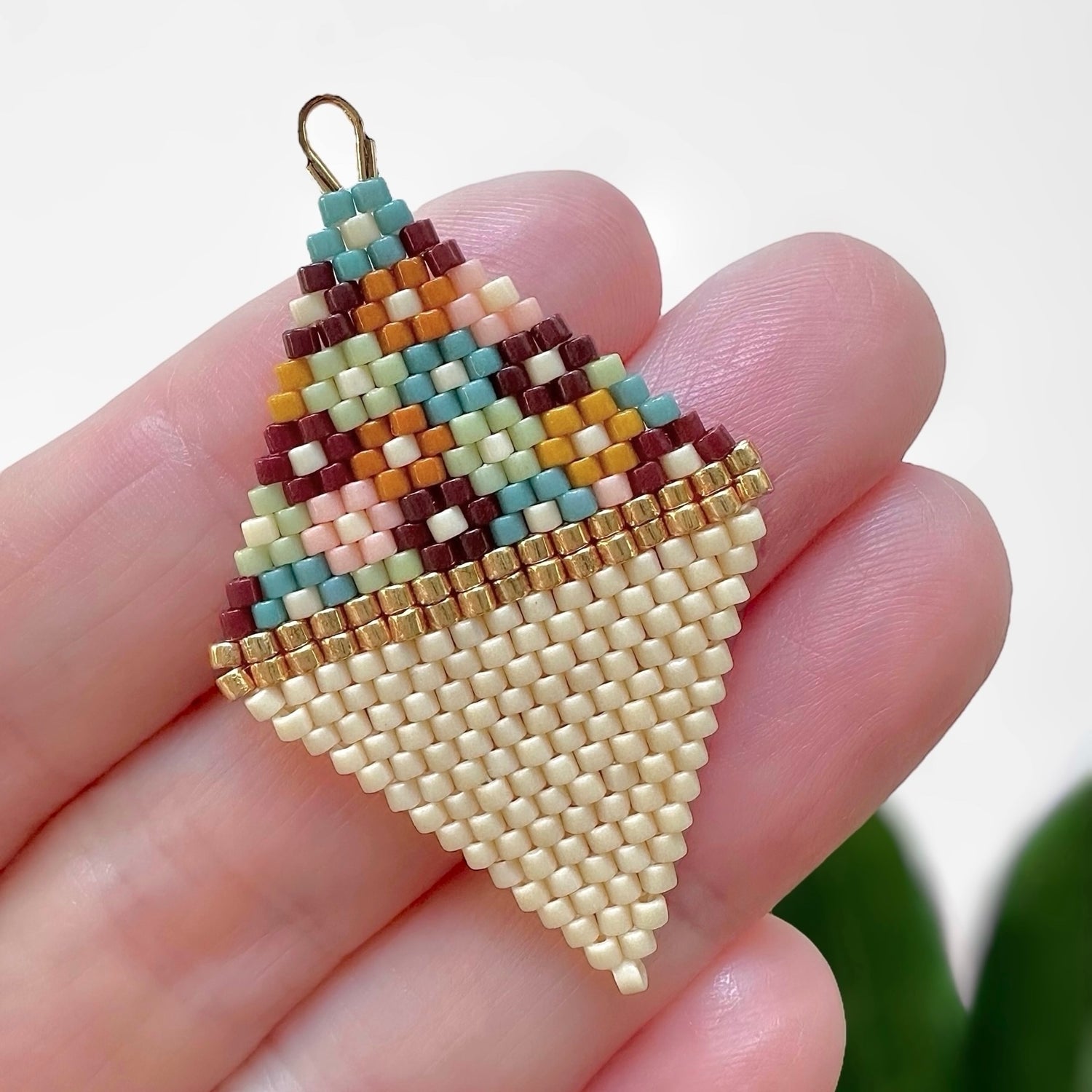
Bead Embroidery
Seed beads are often used as embellishments through bead embroidery. Using a needle and thread, they can be sewn onto fabric, bags, belts, shoes, hats, costumes, and more to create beautifully textured designs and add some sparkle. Bead embroidery can also be used to create beaded brooches as shown below.
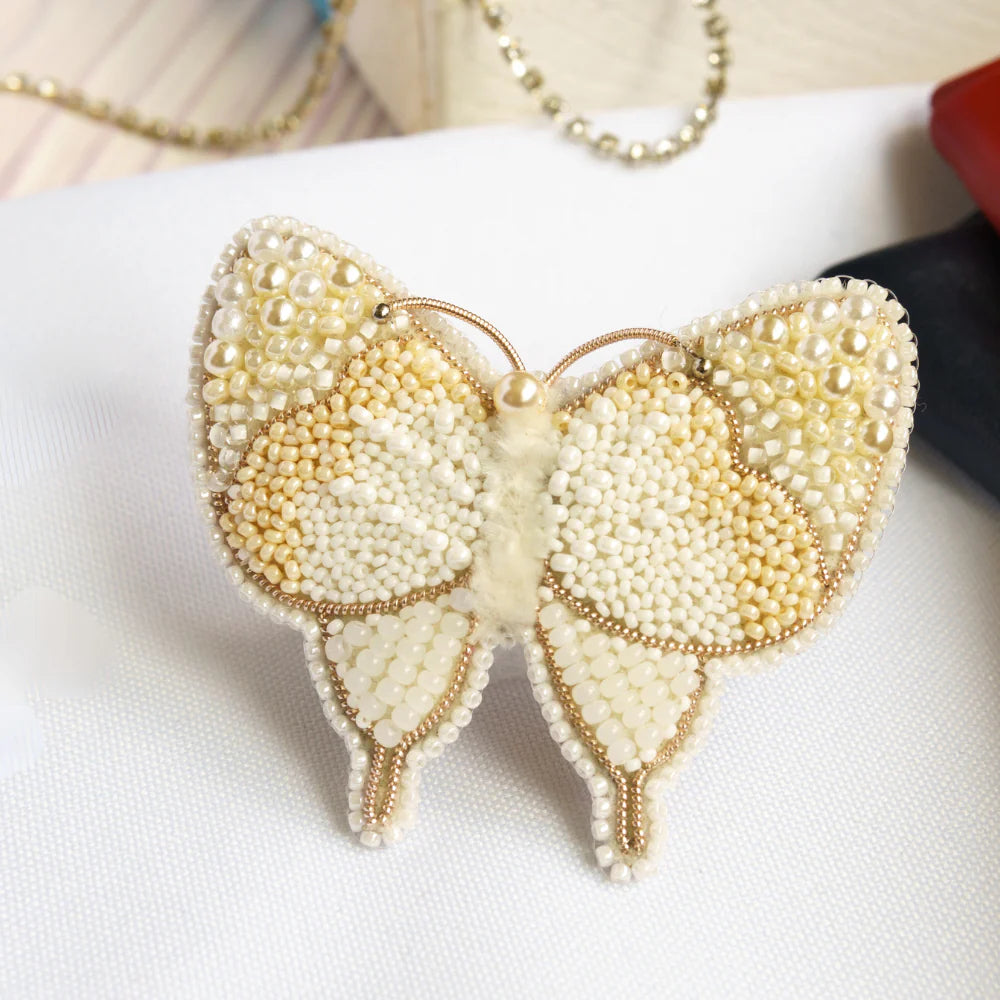
Beaded Fringe
Beaded fringe earrings are very popular. You can either add fringe to beading frames as shown below or to weaved beads.
Seed beads may also be used to create decorative fringe on items such as clothing, curtains, lampshades, and more. Fringe adds movement and visual interest to these items. And the beads add a touch of sparkle.
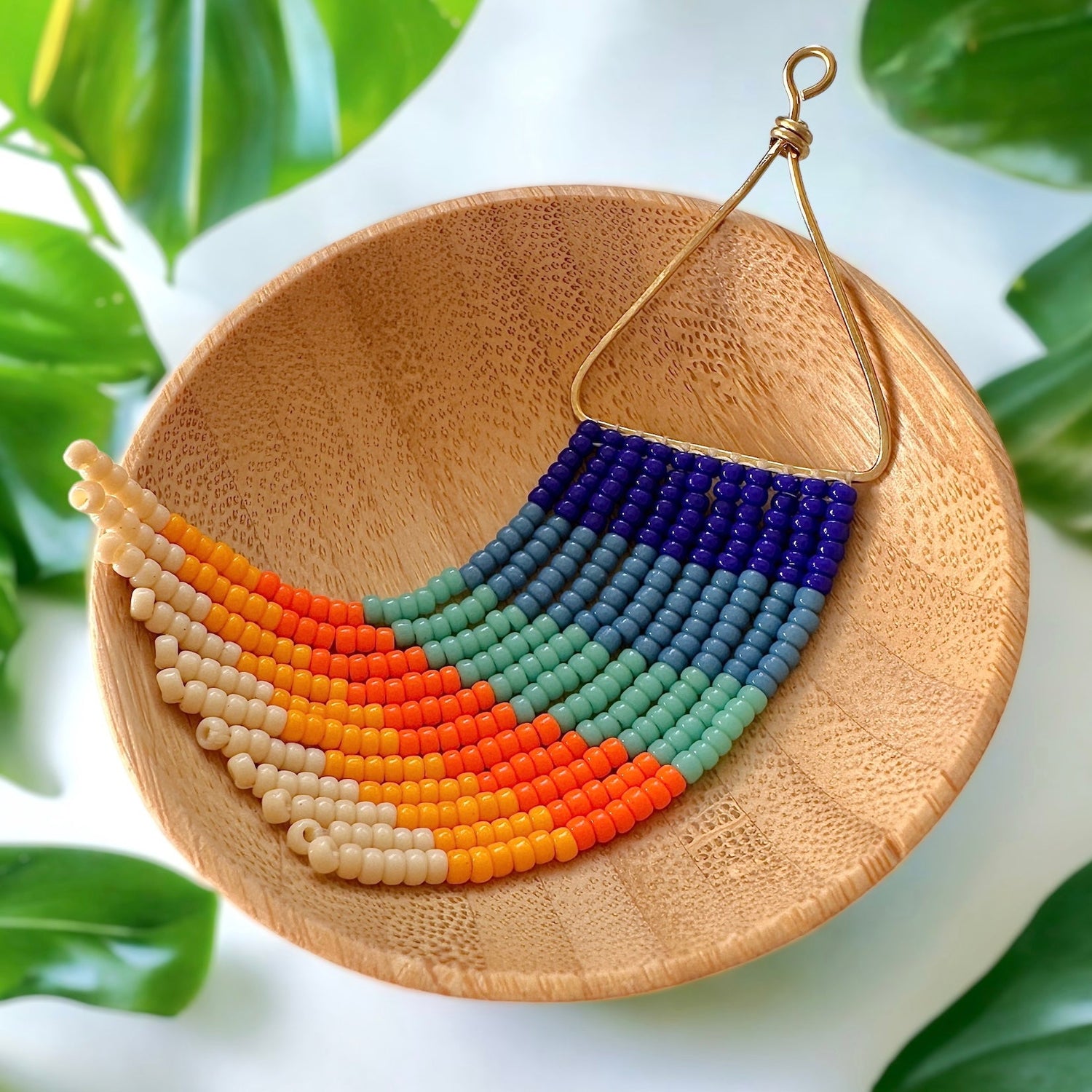
Home Decor & Ornaments
Seed beads can be incorporated into decorative items like picture frames, vases, and candle holders to add a unique and artistic touch. They can also be used to create beautiful ornaments.
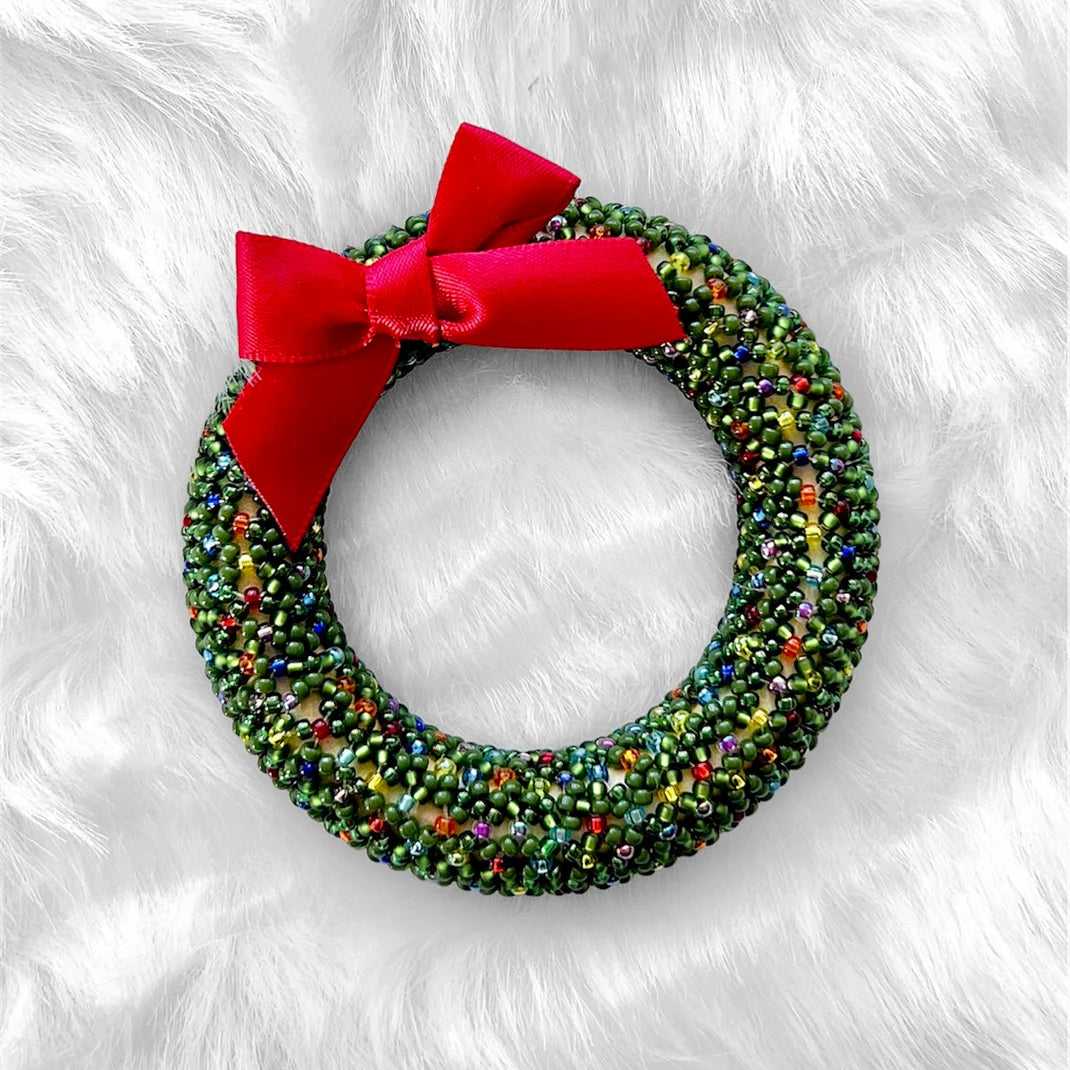
Ceremonial and Cultural Items
Seed beads have been used traditionally by various cultures to create ceremonial garments, regalia, and symbolic ornaments that hold cultural and historical significance.
Crafts
Last but not least, seed beads can be used to create many different types of crafts. Some examples include beaded flowers and trees as well as beaded animals and figurines.
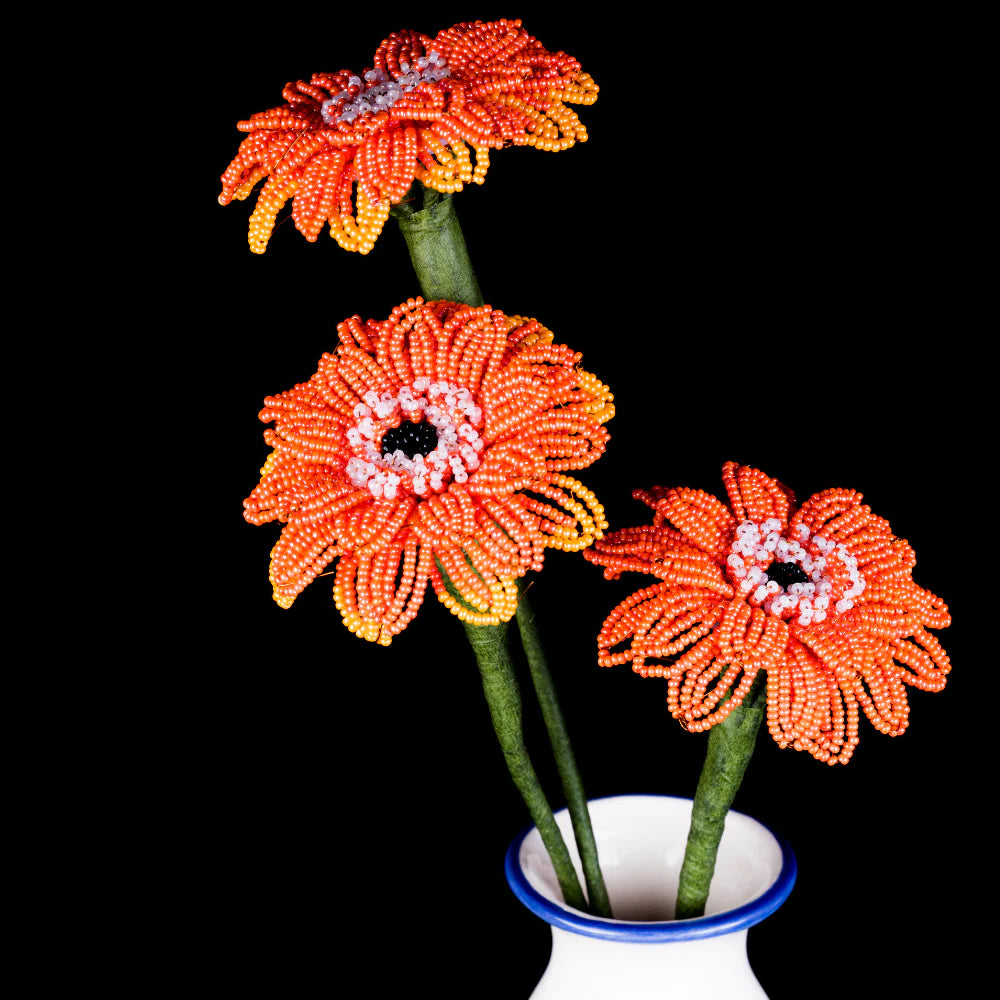
The versatility of seed beads lies in their small size and wide range of colors and finishes. From a single-stranded piece of jewelry to more intricately woven pieces and crafts. The possibilities are truly endless!
Seed Bead Manufacturers
There are lots of options when it comes to seed beads. The highest quality glass seed beads are made in Japan or the Czech Republic.
Japanese Seed Beads: Precision and Consistency
Japanese seed beads are known for their exceptional quality and uniformity. Manufacturers like Miyuki and Toho have perfected their techniques, resulting in beads that are remarkably consistent in size and shape. Their consistent sizing makes them ideal for bead weaving, looming, embroidery, and more. When weaved together, the beads fit perfectly together, which is necessary when creating intricate patterns and designs. This is appreciated by experienced beaders but also important for beginners too. Using uniform beads will save you lots of headaches while trying to learn new techniques.
Czech Seed Beads: A Touch of Character
Czech seed beads, while also high-quality, offer a slightly more organic feel. While generally uniform, they can exhibit slight variations in size and shape, adding a unique charm to your designs. This subtle variation can be particularly appealing for projects where a more natural, handcrafted aesthetic is desired. Czech seed beads are available in a broad range of sizes, similar to Japanese beads, and are a cost-effective option for larger projects. They are a popular choice for stringing, embroidery, and general crafting.
Seed Bead Sizing: Smaller Number = Bigger Bead
Seed beads come in a range of sizes. The most important thing to remember is that seed bead sizes are indicated by a number, and it works in the opposite way you might initially think:
Smaller numbers mean larger beads. A size 6/0 bead is much larger than a size 15/0.
Larger numbers mean smaller beads. A size 15/0 bead is tiny and delicate.
What do the seed bead numbers mean?
These numbers originally referred to how many beads would fit in a linear inch. So, theoretically, 11 size 11/0 beads would line up to roughly one inch. However, with modern manufacturing variations, this doesn’t always hold true. For example, there are about 19 Miyuki 11/0 seed beads per inch.
Common Seed Bead Sizes
Here are some of the most common sizes you'll encounter:
Size 6/0: These are the largest commonly available seed beads. They're great for projects where you want the beads to be very visible, like stringing or using them as spacers.
Size 8/0: A bit smaller than 6/0, these are still quite versatile and can be used for a variety of projects.
Size 11/0: This is the most popular size! They're small enough for detailed work but still easy to handle. You'll find them used in everything from bead weaving to stringing.
Size 15/0: These are the smallest common size. They're perfect for intricate designs and creating a very smooth texture.

Things to Consider about Seed Bead Sizes
Manufacturer Variations: Even within the same size number, there can be slight variations between different manufacturers (like Miyuki vs. Toho). This is especially true for shapes other than round.
Shape Matters: The shape of the bead also affects its size. A size 11/0 Delica bead will be a different size and shape than a size 11/0 round bead.
Hole Size: The size of the hole in the bead is also important, especially when choosing your thread or needle. It’s important to note that hole sizes vary among brands and sizes.
Tips for Working with Seed Bead Sizes
Use a Sizing Chart: A bead sizing chart can be a very helpful visual tool, especially when you're starting out.
Consider Your Project: The size of the bead you need will depend on the type of project you're doing. Intricate beadwork will require smaller beads, while simpler projects might be better suited to larger ones. If you’re following a tutorial, use the recommended bead size to start.
Don't Be Afraid to Experiment: Try working with different sizes to see what you like best. You might even find that mixing sizes adds an interesting element to your designs.
Seed Bead Shapes
While the classic "round" seed bead is what most people picture, there's actually a fascinating variety of seed bead shapes, each with its own unique characteristics. Here are some of the most common ones:
-

Round (Rocaille)
These are your classic seed beads, the most versatile and widely used. They have a rounded, donut-like shape and come in a huge range of sizes. As we discussed, Japanese round beads tend to be more uniform, while Czech rounds may have slight variations.
-

Delica/Cylinder
These beads are shorter and more cylindrical than round beads, with straight sides and a larger hole. This makes them excellent for bead weaving and techniques that require multiple passes of thread. They create a very even, textured look. Miyuki Delicas are the most popular type of cylinder bead.
-

Bugle Beads
Long and tubular, bugle beads add a linear element to designs. They come in various lengths and can be used to create fringes, edgings, or geometric patterns.
-

Triangle Beads
These beads have a triangular cross-section, adding a unique faceted sparkle to projects. They can be used to create interesting textures and patterns.
-

Square Beads
As the name suggests, these beads are cube-shaped. They offer a geometric look and can be used to create structured designs.
-

Drop Beads
These beads are teardrop-shaped, with one rounded end and one pointed end. They add movement and dangle to jewelry and can be used to create beautiful fringes.
-

Hex Cut Beads
These beads have a hexagonal cross-section, giving them more facets and sparkle than round beads.
-

Magatama Beads
These are elongated beads with a curved shape, often used to create textured surfaces and fringe.
-

Bead Shape Chart
This chart contains graphics for the shapes discussed as well as a few others you may encounter when bead shopping or browsing tutorials.
It's important to note that different manufacturers may have slightly different names for these shapes, and there can be variations within each category. For example, some round beads might be more "donut" shaped, while others are more spherical.
Seed Bead Shape Considerations
The design: What kind of look are you trying to achieve? Do you want a smooth, even surface, or something more textured and dimensional?
The technique: Some shapes are better suited for certain techniques than others. For example, cylinder beads are ideal for bead weaving, while round beads are more versatile.
The size: The size of the bead will also affect its appearance and how it works in a design.
Here at The Bead Mix, we sell mostly Miyuki round and Delica beads. Learn more about the differences here.
Finishes and Coatings: Adding Sparkle and Durability
The finish or coating applied to a seed bead dramatically affects its appearance and durability. Here are some common options:
-

Transparent
These beads allow light to pass through, revealing the color of the glass itself. They offer a clean, classic look.
-

Color-Lined
Transparent beads with a colored lining inside the hole. This creates a subtle halo effect and can add depth to the bead's color. The lining can sometimes be prone to wear.
-

Opaque
These beads have a solid color that doesn't allow light to pass through. They offer a bold, vibrant look.
-

Dyed/Stained
Beads that have been dyed or stained to achieve a specific color. Dyed beads can either be transparent or opaque.
-

Matte/Frosted
Beads with a slightly frosted or textured surface, reducing the shine and creating a softer look. Matte beads can either be transparent or opaque.
-

Pearl/Luster
This coating adds a pearly sheen to the bead, giving it a subtle shimmer.
-
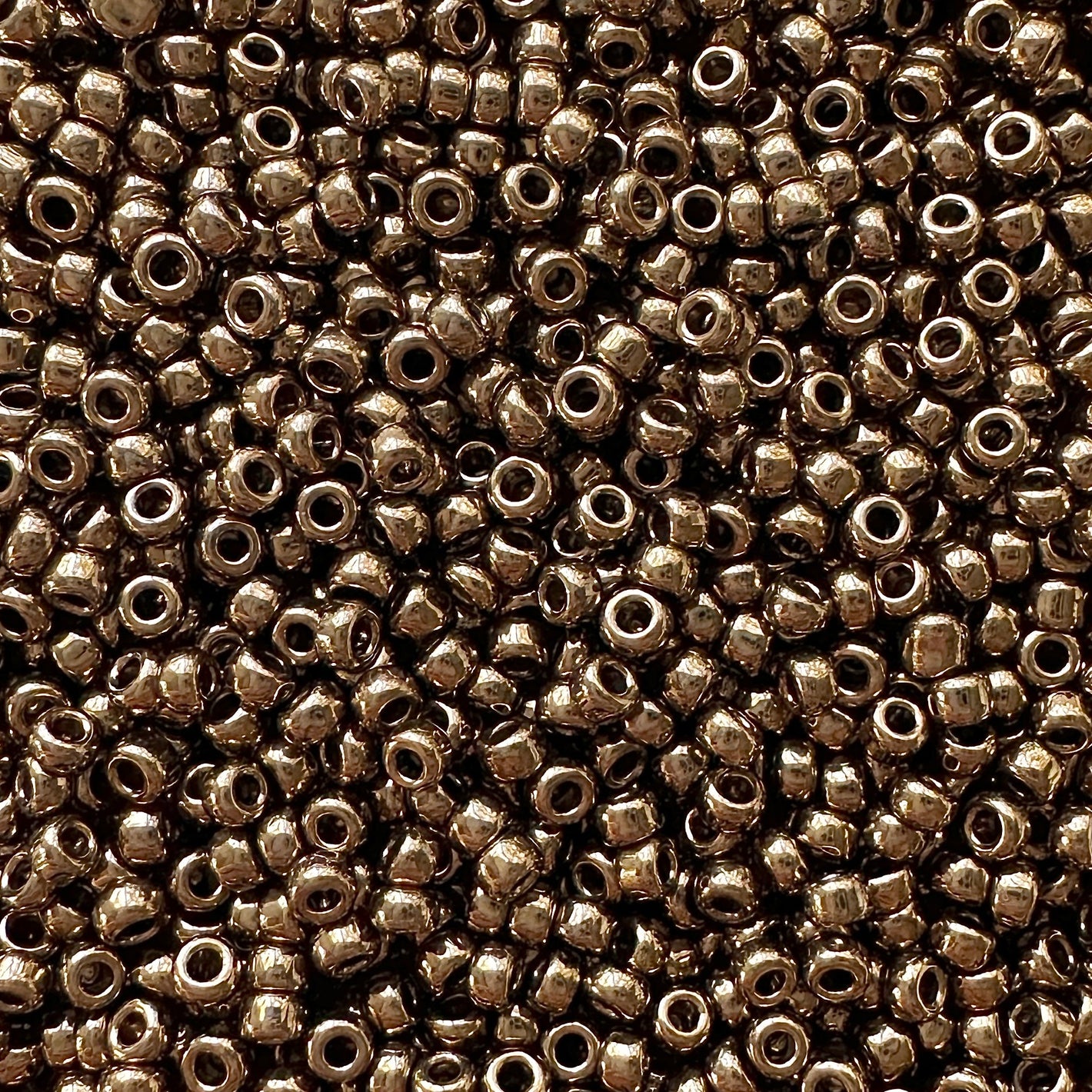
Metallic
Coatings that mimic the look of metals like gold, silver, copper, and bronze. These can add a touch of elegance and sophistication to designs.
-

Galvanized
A type of metallic coating.
-

AB (Aurora Borealis)/Rainbow
This iridescent coating creates a rainbow effect. The AB coating can be added to both transparent and opaque beads. And the beads may either be matte or shiny.
-

Picasso
A speckled or mottled finish that resembles the work of the artist Picasso. Adds a unique, textured look.
-

Iris
Similar to AB, but often with a more pronounced rainbow effect.
-

Silver-Lined
Transparent beads with a silver lining inside the hole, similar to color-lined but with a more metallic flash. Silver-lined beads come in both shiny and matte.
-

Ceylon
Ceylon finishes are often associated with pastel colors, enhancing their soft and delicate appearance with a soft sheen.
-

Duracoat
This is a more durable finish offered by Miyuki, designed to resist fading and scratching, especially important for frequently worn jewelry. It's generally applied to dyed and galvanized beads.
Important Considerations When Choosing Finishes:
Durability: Some finishes are more durable than others. For more information on the durability of finishes and coatings, check out this article.
Appearance: The finish of the bead will greatly affect the overall look of your design. Consider the style and aesthetic you're trying to achieve.
Cost: Some finishes are more expensive than others. This is why some of our bead mixes are priced higher than others.
Choosing the Right Beads for Your Project
The best seed bead for your project depends on several factors, including the design, your budget, and your personal preference. For intricate beadwork requiring precise uniformity, Japanese seed beads are an excellent choice. For projects where a slightly more organic look is desired, or for larger projects where cost is a consideration, Czech seed beads are a great option. Experiment with different sizes, finishes, and coatings to discover the perfect combination for your unique creations. The great thing about our bead mixes is that they usually contain a blend of different finishes to increase visual appeal and offer a designer look.
Where to buy seed beads?
Of course we hope you shop our collection of seed beads, bead mixes, Delica bead sets, jewelry findings, and supplies! But you'll want to branch out and explore other shops too. Click here to learn more about shopping for seed beads and links to customer recommended online bead shops.
Ultimate Beginner's Beading Kit
We put together a carefully curated kit with all the things you need to get started creating jewelry with seed beads. Tools, beads, thread, jewelry findings, and more! So if you want to save yourself time and money, check it out here.
Browse Our Best-Selling Bead Mixes
-
Stormy 11/0 Miyuki Seed Bead Mix
Regular price $7.25 USDRegular priceUnit price per -
Boho Rainbow 11/0 Miyuki Seed Bead Mix
Regular price $7.75 USDRegular priceUnit price per -
Succulent 11/0 Miyuki Seed Bead Mix
Regular price $8.00 USDRegular priceUnit price per -
Southwest 11/0 Miyuki Seed Bead Mix
Regular price $8.25 USDRegular priceUnit price per
























